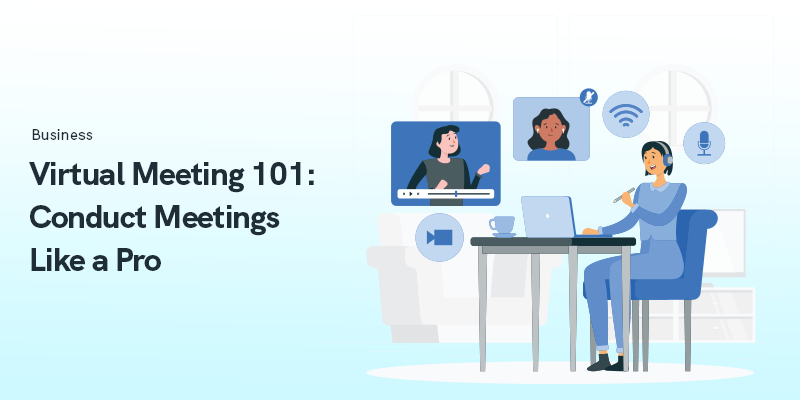
Virtual Meeting 101: Conduct Meetings Like a Pro
Over recent years, dramatic transformations have occurred in business communication. The advent of remote work and technological advancements have given rise to virtual meetings, forever changing how we connect, collaborate, and communicate.
Recent studies have shown that over 80% of workers now believe video conferencing is crucial to their work life.
Virtual meetings, taking place over platforms like Microsoft Teams, offer unique advantages such as convenience, flexibility, and cost-effectiveness. They've swiftly moved from being an optional mode of communication to an essential part of our professional lives. Virtual meetings have become a staple in various industries, from small team huddles to large-scale international conferences.
However, navigating this new terrain can be challenging. With the right skills and knowledge, virtual events can quickly become productive and enjoyable experiences. That's why mastering the art of conducting virtual meetings is paramount.
This blog post will provide a comprehensive guide on the proper virtual meeting. etiquette in ‘Virtual Meetings 101', ensuring you can conduct your meetings like a pro in this digital era.
Understanding Virtual Meetings
Virtual meetings, also known as online or remote meetings, are real-time interactions over the Internet. Participants from different locations can connect and communicate using audio, video, and text-based mediums. These meetings eliminate geographic barriers, enabling individuals and businesses to interact seamlessly regardless of where they are.
Several platforms facilitate virtual events, each with unique features:
MEC Virtual Events Addon
A valuable tool for managing virtual meetings and events. Virtual Events addon simplifies the process of scheduling, inviting attendees, and managing the meeting itself. With compatibility across various video conferencing platforms, it ensures accessibility for all participants.
Plus, it offers crucial features like event reminders, and attendee management, enhancing productivity and effectiveness. challenges.
Zoom
Known for its user-friendly interface, Zoom offers high-quality video and audio conferencing. It supports screen sharing and recording meetings and has breakout rooms for smaller group discussions within a more significant meeting.
Microsoft Teams
Integrated with the Microsoft Office Suite, Teams allows for easy collaboration on documents during meetings. It also offers chat functionality, file sharing, and customizable backgrounds.
Google Meet
As part of the Google Workspace, Meet integrates with tools like Google Calendar and Gmail. It offers live captioning, low-light mode, and noise-cancellation features.
Miro
Unlike traditional video conferencing, Miro is a visual collaboration platform with other meeting software. It provides interactive whiteboards perfect for brainstorming sessions and project planning.
Digital Wall Calendar
This innovative tool helps organize and schedule virtual meetings easily. Integrated with various platforms like Zoom, Microsoft Teams, and Google Meet, it displays all your meetings in one place.
The digital wall calendar also sends reminders for upcoming meetings, ensuring you never miss an important discussion. It's an excellent tool for teams working remotely as it visually represents everyone's schedule, promoting better coordination and efficient time management.
Advantages of Virtual Meetings
- Convenience: Participants can join the meeting from anywhere, anytime, reducing travel time and expenses.
- Increased Participation: People who might not usually speak up in face-to-face meetings may feel more comfortable contributing in a virtual setting.
- Cost-effective: Companies can save on travel, accommodation, and venue costs.
- Record Keeping: Most virtual meeting platforms allow users to record and transcribe meetings quickly for later reference.
Disadvantages of Virtual Meetings
- Technical Issues: Poor internet connection and hardware or software failures can disrupt meetings.
- Lack of Personal Interaction: Non-verbal cues can be lost in virtual meetings, potentially leading to miscommunication.
- Distractions: Participants may be more prone to distractions in their environment compared to a controlled office setting.
- Time Zone Differences: Coordinating meeting times across different time zones can be challenging.
Despite the challenges, the advantages of virtual meetings often outweigh the disadvantages, especially in today's business communication. With the right strategies and planning tools, virtual meetings can be just as effective, if not more so, than traditional face-to-face meetings.
Preparing for a Virtual Meeting
Just like traditional face-to-face meetings, preparation is vital to the success of virtual meetings. Here's what you need to do:
Technical Setup
Reliable Internet Connection: Nothing disrupts a virtual event more than a poor internet connection. Ensure you have a stable and high-speed connection to prevent any disruptions during the meeting.
Appropriate Hardware and Software: Ensure your device (laptop, desktop, tablet, or smartphone) has the necessary hardware specifications to run the meeting software smoothly. This includes having a good-quality webcam and microphone.
Professional Environment: Choose a quiet location with minimal background noise. The environment behind you should look professional, as it adds to the overall impression you make. A virtual background can be a good option if your surroundings are not ideal.
Pre-Meeting Communication
Effective communication before the meeting can set the tone and expectations for office meetings, leading to more productive sessions.
Sending out Invites: Use a tool like Google Calendar or Outlook to send out invites for remote meetings. Include the date, time (considering different time zones if necessary), and the link to join the session.
Sharing the Agenda: Send out the agenda in advance. This gives attendees an idea of what to expect and allows them to prepare accordingly. You can create and share agendas with remote attendees using Trello or Asana.
Pre-meeting Materials: If some documents or presentations meeting participants need to review before the meeting, share them beforehand. Share files with tools like Google Drive or Dropbox.
By investing time in proper preparation, you increase the chances of the meeting hosting your virtual meeting running smoothly and ensure that participants can fully engage and contribute to the discussion.
Conducting the Virtual Meeting

Running a successful virtual meeting involves more than logging in and starting the conversation.
Here are some critical aspects of a virtual call to consider:
Virtual Meeting Etiquette
Starting on Time and Respecting the Schedule: Just as with in-person meetings, starting and ending virtual meetings on time is crucial. This shows respect for participants' time and schedules. Scheduling meetings ensure all critical points on the meeting agenda are covered within the allotted time.
Setting Ground Rules: Establish clear guidelines for participation and interaction. For example, ask participants to mute their microphones when not speaking to minimize background noise or use the ‘raise hand' feature for questions or comments. These rules help maintain order and ensure everyone gets a chance to contribute.
Managing Discussions
Encouraging Participation: Actively encourage everyone to participate. You can call on individuals directly or ask open-ended questions to stimulate discussion.
Handling Interruptions: In case of interruptions, leave the room or politely steer the conversation back on track. If someone dominates the discussion, tactfully intervene and give others a chance to speak.
Dealing with Technical Issues: Be patient and understanding if participants encounter technical issues. If necessary, have a backup plan, such as a dial-in option for those having trouble with video.
Tools and Features
Most virtual meeting platforms offer a range of tools and features to enhance your meetings:
- Screen Sharing: This allows you to share your screen with others, useful for presentations, demonstrating a process, or discussing a document.
- Virtual Backgrounds: These can mask your natural background, adding a professional touch or a bit of fun to your meetings.
- Breakout Rooms: On platforms like Zoom, you can split your meeting into smaller groups for more focused discussions and bring everyone back together.
- Chat Feature: Participants can use this to ask questions or share links without interrupting the speaker.
By following these guidelines, you can ensure your virtual meetings with team members are productive but also engaging and inclusive for all participants.
Effective Communication in Virtual Meetings
Effective communication is the linchpin that holds a virtual event together. It's more than just speaking clearly; it's also actively listening and engaging with others.
Here are some tips to improve your communication during virtual meetings:
Verbal and Non-Verbal Communication
Speaking Clearly: In a virtual setting, your voice is one of your main tools for communication. Speak clearly and at a moderate pace, ensuring your microphone is working well. Avoid using jargon or complex terms that might confuse participants.
Using Appropriate Body Language: Even though you're not physically present, non-verbal cues such as facial expressions, gestures, and body posture still matter. Maintain eye contact by looking into the camera, using gestures to emphasize points, and ensuring your posture reflects attentiveness.
Active Listening and Engagement
Active Listening: This involves hearing and understanding and interpreting what someone is saying. Show that you're paying attention by nodding, giving verbal affirmations, and asking follow-up questions.
Engagement: Encourage interaction and participation. Use people's names when addressing them, ask for their opinions, and respond to their comments or questions. This can make the meeting more engaging and productive.
Handling Q&A Sessions
Q&A sessions can often be the most interactive part of a virtual meeting. Here are some tips to handle them effectively:
- Set Clear Guidelines: At the beginning of the meeting, let participants know how and when they can ask questions (e.g., using the chat box, raising their hand, or waiting until a designated Q&A time).
- Moderate Fairly: Make sure everyone gets a chance to ask their question. If one person is dominating, politely ask them to hold their questions until others have had an opportunity.
- Be Prepared: Anticipate possible questions based on the meeting agenda and prepare your responses. If you don't know the answer to a question, it's okay to say so and promise to follow up later.
By focusing on these areas, you can foster effective communication in virtual meetings, making them more productive and enjoyable for all participants.
Post-Meeting Follow-up

The completion of a virtual meeting doesn't signify the end of responsibilities. A crucial part of the process involves post-meeting follow-ups that ensure the effectiveness and productivity of the entire meeting itself.
Importance of Post-Meeting Follow-ups
Post-meeting follow-ups serve several essential purposes:
- They ensure that all participants agree regarding decisions made and tasks assigned during the meeting.
- They provide a record of the meeting for future reference.
- They keep the momentum going, ensuring that the ideas and actions discussed in the meeting are carried forward into actual work.
Sending Out Meeting Minutes and Action Items
Meeting Minutes: These meeting notes are a detailed record of what was discussed, decisions made, and action items assigned during the meeting. It's best to send these out as soon as possible after the meeting when everything is still fresh. Create and share the minutes with tools like Google Docs or Microsoft Word.
Action Items: These are specific tasks assigned to individuals during the meeting. Clearly state the action item, who is responsible, and the deadline. Easily keep track of the functions with Trello or Asana.
Seeking Feedback for Continuous Improvement
To improve the quality of future meetings, seeking participant feedback is valuable. You can ask for feedback on various aspects, such as the meeting's duration, communication effectiveness, the usefulness of the content discussed, etc. This feedback can be collected through a quick survey using tools like Google Forms or SurveyMonkey.
Remember, the goal of a post-meeting follow-up is to facilitate effective communication, ensure accountability, and continuously improve your virtual meeting etiquette rules and processes. By doing this diligently, you can significantly enhance the productivity and effectiveness of your virtual meetings.
Tips and Tricks for Successful Virtual Meetings

While the basics of conducting an excellent virtual meeting etiquette are straightforward, many additional tips and tricks can take your meetings from good to great. Here are some of them:
- Test Your Tech: Before starting, test your internet connection, audio, video, and any other technology you plan to use. Ensure your meeting platform is up-to-date and compatible with all participants' devices.
- Create an Agenda: A well-structured agenda can make your meeting more productive. Share it in advance so participants know what to expect and come prepared.
- Use Video: Encourage everyone to turn on their cameras whenever possible. Seeing each other's faces can make the meeting more engaging and foster better connections.
- Minimize Distractions: Choose a quiet place for your meeting, and mute any notifications that could interrupt the flow. Ask participants to do the same.
- Be Inclusive: Ensure everyone has the opportunity to participate. This makes the meeting more interactive and ensures that all perspectives are heard.
- Record the Meeting: If your platform allows, record the meeting. This can be useful for those who couldn't attend or need to refer to the discussion.
- Use Interactive Features: Many platforms offer features like polls, quizzes, and whiteboards that can make your meeting more interactive and engaging.
- Breaks for Longer Meetings: If your meeting will last more than an hour, schedule short breaks to prevent fatigue and maintain focus.
- Professional Appearance: Dress as if attending an in-person meeting. This shows respect for the other participants and sets a professional tone.
- Support for New Tools: If you're using a new tool or feature, provide a brief tutorial or support materials to help participants get up to speed.
- Prioritize Security: Ensure the security of your virtual meetings by using a VPN, especially when connecting over public or unsecured networks. This helps protect sensitive information and maintain privacy.
By incorporating these tips and tricks, you can elevate the effectiveness of your virtual meetings, making them more engaging, productive, and inclusive.
Conclusion
Virtual meetings have become vital for collaboration and decision-making. They allow us to connect with colleagues, partners, and clients across distances, breaking down geographical barriers. However, to reap the full benefits of this mode of communication, it's crucial to conduct these online meetings effectively.
From ensuring clear verbal and non-verbal communication, practicing active listening and engagement, handling Q&A sessions efficiently, diligent post-meeting follow-ups, and applying various virtual event etiquette tips and tricks, each aspect contributes significantly to the success of your virtual meetings.
The benefits of effective virtual meetings are numerous. They save time and resources, enhance productivity, foster better collaboration, and ensure everyone is aligned toward common goals. Moreover, they provide an opportunity to improve continuously through feedback and iterative learning.
So, as you gear up for your next virtual meeting, remember to apply these strategies and techniques. They will make your meetings more successful and transform them into a powerful tool for driving your team's performance and results. Here's to more productive and engaging virtual meetings ahead.
Recommended Posts

10 Best AI Tools for Event Planners & Businesses in 2025
January 22, 2025



